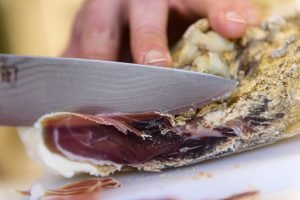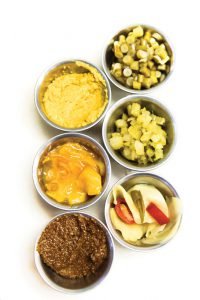+ By Desiree Smith-Daughety + Photos by Alison Harbaugh
When you see the sign for The Ugly Pig, don’t go into the store expecting a barbeque joint. This is not your average franchised sandwich shop, either. On the contrary, this hub of culinary delights will meet the lofty standards of foodies, mission-driven environmentalists, and health-conscious eaters alike.
 George Williams IV, proprietor of the establishment, offers a different way to celebrate these porcine animals. They are Spanish-heritage Ossabaw-breed hogs, raised locally in Davidsonville on non-genetically modified pasture and forest—the way wild pigs are raised in Spain. Williams’ charcuterie is from this breed, minus the environmental impacts of importing it from afar. Butchery is done at the store, giving Williams the freedom to make nontraditional cuts and keep waste to a minimum, make bone broth, render lard, and make his dry-cured, unique-flavored bacon, which is so popular that he can’t seem to keep it stocked. When the charcuterie is cured, he slices it by hand—his nod to how the Spanish do it.
George Williams IV, proprietor of the establishment, offers a different way to celebrate these porcine animals. They are Spanish-heritage Ossabaw-breed hogs, raised locally in Davidsonville on non-genetically modified pasture and forest—the way wild pigs are raised in Spain. Williams’ charcuterie is from this breed, minus the environmental impacts of importing it from afar. Butchery is done at the store, giving Williams the freedom to make nontraditional cuts and keep waste to a minimum, make bone broth, render lard, and make his dry-cured, unique-flavored bacon, which is so popular that he can’t seem to keep it stocked. When the charcuterie is cured, he slices it by hand—his nod to how the Spanish do it.
The Ugly Pig does not just specialize in charcuterie. Surprisingly, another bestselling item is his chicken salad. Williams shops exclusively from farms and farmers’ markets, allowing him to offer non-GMO, organically sourced ingredients for everything in the store, including what goes into each chicken salad sandwich. Williams makes everything on the premises, from the fermented celery to the mayonnaise, mustard, and vinegar.
 Pickling got Williams started on this venture. Starting at age 16, he enjoyed making pickles for people at Christmas. What became a means for selling pickles grew to what Williams terms a “philosophical store,” representing his sustainability values. His route was a bit circuitous. He managed his college’s greenhouse, gardened on rooftops, and ran a seed-saving program in Maine. Williams has a master’s degree in art history and museum studies, and researched Southeast Asian ceramics. “I enjoy traveling a lot and frequently asked landlords to teach me their home style cooking techniques. I have a large food-based memory bank.”
Pickling got Williams started on this venture. Starting at age 16, he enjoyed making pickles for people at Christmas. What became a means for selling pickles grew to what Williams terms a “philosophical store,” representing his sustainability values. His route was a bit circuitous. He managed his college’s greenhouse, gardened on rooftops, and ran a seed-saving program in Maine. Williams has a master’s degree in art history and museum studies, and researched Southeast Asian ceramics. “I enjoy traveling a lot and frequently asked landlords to teach me their home style cooking techniques. I have a large food-based memory bank.”
The store itself was a restoration project—living by the Bay has its downsides when it comes to dampness and structures. With help from his indispensable sideman (and current helping hand in the store’s operations) Dave, he rebuilt walls, laid a floor, and put in a curing room. Williams gave a few nods to the Freer and Sackler Galleries, the Smithsonian museum where he worked, with the handmade, hand-died rugs from Iran and the photos shot by a Smithsonian friend of pigs at the farm, framed in the style that he once framed museum works. When Williams’ endowment ran out at the Smithsonian, he decided it was time to “join the food conversation that is taking place nationally.”
Art history and international culinary experimentation provide some of the roots for Williams’ house made foods. There is a lot of Asian influence, including smoked Japanese plums, miso, and a spicy, fermented Korean condiment called gochujang. Also on hand are quintessentially American offerings such as homemade peanut butter. Williams ferments items in the store, including apple cider vinegar and a range of seasonal items. He hasn’t forgotten his pickling roots, and with a smile shares an expression he uses—vegetablism—saying, “It’s vegetalist to think all pickles come from cucumbers. We pickle everything we can, all year long. I’m pickling turnips and beets now, and will do carrots, cucumbers, daikon . . . All year long, there is plenty of stuff to pickle.”
 While all of the menu’s offerings are organically grown or raised, the menu itself has an organic quality, changing with seasonal food availability. At any given time of the year, you’ll find something seasonal rotating in, and a mainstay such as hummus, potato salad, seasonal jams, or veggie salads, or a split pea soup with ham that Williams has baked, along with stock from reserve ham fluid and fat (he makes his own ham glaze). You may find a mango-mole sandwich for a day’s offering, made with mango that Williams marinated and his own mole paste.
While all of the menu’s offerings are organically grown or raised, the menu itself has an organic quality, changing with seasonal food availability. At any given time of the year, you’ll find something seasonal rotating in, and a mainstay such as hummus, potato salad, seasonal jams, or veggie salads, or a split pea soup with ham that Williams has baked, along with stock from reserve ham fluid and fat (he makes his own ham glaze). You may find a mango-mole sandwich for a day’s offering, made with mango that Williams marinated and his own mole paste.
Williams’ business model celebrates the area’s farming tradition of the last 400 years while incorporating the international foods that Americans enjoy, without creating a big carbon footprint. His nontraditional foods are gaining traction and garnering reviews. He deliberately cast a wide food net in case something failed—and so far, that hasn’t occurred. Annapolitans who are food savvy comprise his growing market. “There are many people looking for a place with food that blends innovation and new trends along with the classicism they expect. They want a really good sandwich, and are also looking for a marketplace that acts as a bridge to the farmers’ markets—a place that celebrates what’s local.”
One thing you won’t encounter at the Ugly Pig is smoke and mirrors. Williams is committed to transparency. Ask him a question about any ingredient, and he can tell you where it was sourced, down to how much was used. He wants to show how easy it is to transform foods into something special with the items he sells, providing ideas for what customers can do at home.
As for Williams, even with his exceptional, conscientious efforts, his aspirations for The Ugly Pig are modest: “I would be honored to receive the “best sandwich” award, and it’s a dream of mine to see my yellow mustard in the Bowie Baysox Stadium!” █








































